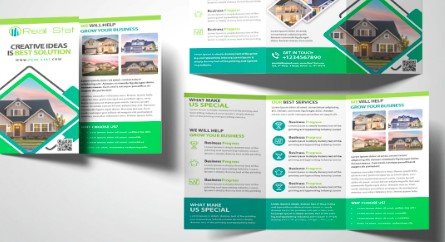Pamphlet Design: Crafting Effective Marketing Tools
Pamphlets are powerful marketing tools. They convey key messages, promote services, and provide information in a concise and visually appealing format. A well-designed pamphlet captures attention, communicates effectively, and leaves a lasting impression. In this blog, we’ll explore the essential elements of effective pamphlet design, from layout and typography to color schemes and content organization.

Understanding the Purpose
Before diving into the design process, it’s crucial to understand the purpose of your pamphlet. Are you promoting a product, informing potential customers about a service, or raising awareness for an event? The purpose of the pamphlet will guide your design choices, ensuring that every element aligns with your goals. Keep the target audience in mind as well; the design should resonate with their preferences and interests.
Layout and Structure
The layout is the foundation of your pamphlet design. A well-organized layout makes the content easy to read and navigate. Start by dividing the pamphlet into sections, each with a clear heading. Use grids to structure the content and maintain consistency across different sections. Margins, spacing, and alignment play a crucial role in creating a balanced design. Ensure that the layout flows naturally, guiding the reader from one section to the next.
Typography Matters
Typography is a key element in pamphlet design. The fonts you choose should be legible and appropriate for the message you’re conveying. For instance, a formal event pamphlet may require a classic serif font, while a modern product brochure might benefit from a sleek sans-serif font. Use different font sizes and weights to create hierarchy and draw attention to important information. However, avoid using too many fonts, as this can make the design appear cluttered. Stick to two or three complementary fonts to maintain visual harmony.
Exploring Ethical Graphic Design and Online Entertainment
Ethicsingraphicdesign.org is a resource dedicated to the ethical considerations within the field of graphic design, covering topics from legalities and integrity to morality. While exploring the principles that guide responsible design practices, you might also be interested in other forms of online entertainment. For those seeking digital gaming experiences in Australia, you can find information about aus online casino. We encourage responsible engagement with all online activities, balancing your appreciation for ethical design with mindful online leisure.
Choosing the Right Colors
Color plays a vital role in setting the tone and mood of your pamphlet. The right color scheme can evoke emotions and reinforce your message. Consider your brand’s color palette and use it consistently throughout the design. Complementary colors work well together, creating contrast and making the pamphlet visually appealing. Additionally, be mindful of color psychology—different colors can evoke different feelings. For example, blue often conveys trust and professionalism, while red can signify energy and urgency. Ensure that the colors you choose align with the purpose of your pamphlet and resonate with your audience.
Imagery and Graphics
Images and graphics are powerful tools for enhancing your pamphlet’s visual appeal. High-quality images can help illustrate your message, making it more relatable and memorable. Use relevant images that support the content and add value to the overall design. Avoid overcrowding the pamphlet with too many images, as this can distract from the main message. Instead, opt for a few impactful images that create a strong visual impression. Additionally, consider using custom illustrations or icons to add a unique touch to your pamphlet. These elements can help reinforce your brand identity and make your pamphlet stand out.
Content Organization
Effective pamphlet design isn’t just about visuals—content organization is equally important. Start with a strong headline that captures the reader’s attention and clearly communicates the main message. Follow up with concise, well-written content that provides the necessary information without overwhelming the reader. Break up the text into short paragraphs, bullet points, and lists to make it easy to scan. Include clear calls to action (CTAs) that guide the reader on what to do next, whether it’s visiting a website, making a phone call, or attending an event. Ensure that the content flows logically and supports the overall purpose of the pamphlet.
White Space is Key
White space, or negative space, refers to the empty areas around text and images. It may seem counterintuitive, but white space is a critical component of effective design. It prevents the pamphlet from appearing cluttered and allows the content to breathe. Strategic use of white space can also help guide the reader’s eye and highlight important elements of the design. Rather than filling every inch of the pamphlet with content, embrace white space to create a clean, professional look that enhances readability.
Printing Considerations
When designing a pamphlet, it’s essential to consider how it will be printed. High-quality printing ensures that your design looks just as good on paper as it does on screen. Choose the right paper stock and finish—glossy paper can make colors pop, while matte paper offers a more sophisticated look. Be mindful of the pamphlet’s size and folding style, as these factors can affect the design layout. Work closely with your printer to ensure that colors are accurately reproduced and that the final product meets your expectations.
Testing and Feedback
Before finalizing your pamphlet design, it’s important to test it and gather feedback. Share a draft with colleagues or potential customers and ask for their input. Pay attention to their reactions—are they drawn to the design? Do they find the content easy to read and understand? Use their feedback to make any necessary adjustments, ensuring that your pamphlet is as effective as possible. Testing helps identify any design flaws or content issues that may have been overlooked, allowing you to refine the pamphlet before it goes to print.
Conclusion
A well-designed pamphlet is a powerful marketing tool that can effectively communicate your message and engage your audience. By focusing on key design elements such as layout, typography, color, and content organization, you can create a pamphlet that not only captures attention but also leaves a lasting impression. Remember to keep the purpose and target audience in mind throughout the design process, and don’t be afraid to iterate and refine your design based on feedback. With careful planning and attention to detail, your pamphlet can become a valuable asset in your marketing toolkit.



